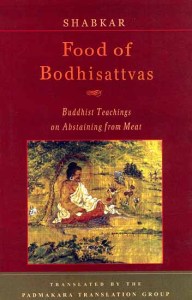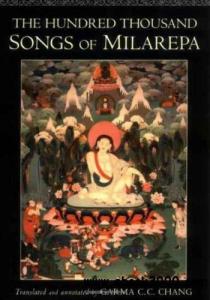 Food of Bodhisattvas: Buddhist Teachings on Abstaining from Meat by Shabkar Tsogdruk Rangdrol (translated by the Padmakara Translation Group). Shambhala 2004. 144 pages.
Food of Bodhisattvas: Buddhist Teachings on Abstaining from Meat by Shabkar Tsogdruk Rangdrol (translated by the Padmakara Translation Group). Shambhala 2004. 144 pages.
I confess I was less than rousingly impressed by this book. While the author, Shabkar, was one of Tibet’s greatest yogi’s since Milarepa, very little of the text is actually from his hand.
The book has three parts. The first, the introduction, is the lengthiest at 46 pages. It discusses something of the history and place of vegetarianism in traditional Tibet, contrasting the situation with Tibetans in exile and Buddhists in the West. The main section of the introduction paints a portrait of Shakar himself. I can only say he must have been an extraordinary character, living homeless much like the Buddha’s early disciples, but instead of hanging out in jungles he lived amid the cold and treeless mountain crags of Tibet.
The intro then discusses the place of meat-eating in Buddhism. The traditions drawn from here–as in Shabkar’s writings–are from the three major “turnings of the wheel,” i.e. shravakayana (Hinayana), Mahayana, and Mantrayana (i.e. Vajrayana, the Buddhism of the tantras). Underpinning everything is the notion that, as diverse and often contradictory as they often are, the Buddha taught all these doctrines as part of a gradual, or graded, dispensation. And so, according to the introduction…
…there exists a hierarchy of teaching, a scale of validity, according to which basic instruction is regarded as provisional, set forth according to need and superseded by higher, more demanding instruction to be expounded when the disciple is ready. For Shabkar, as for all teacher of Tibetan Buddhism the instructions set forth on the Hinayana level are of vital importance in laying the foundations for correct understanding and practice. But they are not final. They are surpassed by the teachings of the Mahayana, just as, within the Mahayana itself, the sutra teachings prepare the way for, and are surpassed by, the tantra. It is thus that the entire sweep of the Buddha’s teaching fits together in a harmonious ad coherent system, in which teachings that seem incomplete from the standpoint of a higher view are assigned an appropriate, preparatory position lower down the scale (16).
This view has prevailed throughout much of the Buddhist world for a long time, and is the result of various cultures (China, Tibet, etc) receiving diverse canons and texts, many of which originated in different periods of Buddhist history, while believing them all to represent the Buddha’s words. Given the discrepancies and outright contradictions of outlooks and practices between the many texts, the approach above is hardly surprising if one assumes they all sprang from one man. Shabkar certainly believed this, and no one can blame him. It irks me, however, that contemporary scholars and practitioners persist in perpetuating this nonsense, given what we now know about the history of Buddhist texts. For example, the Lankavatara Sutra, a widely quoted work that harshly condemns meat-eating, is assumed to be the Buddha’s own words, yet it is clearly a composite work, first translated into Chinese in 443 CE, though probably originating several hundred years earlier. While its dating is tricky, not even its seed ideas can in any way be attributed to Shakyamuni or any of his disciples. (See E.J. Thomas, The History of Buddhist Thought, pp. 230ff.) Similar remarks can be made about every other Mahyanist sutra, not to mention the various, still later tantras.
Following the above, the introduction discusses the notion of “three-fold purity” in the Hinayana (meaning, the Buddha’s teachings in the Pali Suttas), where the Buddha enjoins monks not to eat any meat offering if they have “seen, heard or suspected” it to have been killed specifically for them. This ordinance, totally understandable as applied to mendicant monks, becomes problematic, however, when applied to laity, and this really is the source of the confusion and debate about meat-eating among Buddhists. The Mahayana and Mantrayana (tantric) perspectives on vegetarianism are also discussed.
What bothered me most about the introduction–its moralising and lecturing quality, especially toward the end–got even worse in the second section of the book, entitled “The Faults of Eating Meat.” This is a kind of compendium of Buddhist textual sources on the subject selected and arranged by Shabkar. If one’s goal is simply to learn what Buddhists have said about meat-eating over the years, this section serves admirably. If you are looking for well-reasoned, cogent arguments, look elsewhere. Much of it is hellfire-and-brimstone preaching; apparently the Christians haven’t got anything on the Buddhists in this regard, sad to say. Here’s an inspiring snippet:
It is written in the Sutra Describing Karmic Cause and Effect:
If you eat meat and chew on bones, you will lose your teeth! If you eat intestines and the meat of dogs and swine, you will be reborn in an infernal state that is filled with filth. If you eat fish after scraping off their scales, you will be born in the hell of sword-forests (77).
Very little of this section comes from Shabkar; he simply scoured sutras, tantras and commentaries and took whatever he could find to support his beliefs–a kind of eighteenth century Tibetan cut-and-paste creation. The third part of the book, however, is all Shabkar, though regrettably brief–only 28 pages out of the book’s 144!
Entitled “The Nectar of Immortality,” I found it a well reasoned, impassioned polemic against meat-eating. The principal–and most persuasive–argument here can be summed up as “If there is no meat-eater, there will be no animal killer…” (101). He discusses this idea at length, giving examples of how local monasteries, though themselves not involved in the act of butchery or animal killing, by their plentiful purchases of meat help to sustain the local meat industry.
Which cuts quick to the bone, if you don’t mind the pun. I once had a discussion with a friend on this subject, and he pointed out that I was hardly less guilty of the deaths of animals than the butcher himself since I basically employed the butcher to do the dirty work. Indeed, I couldn’t escape the logic of it then, and readers will be hard pressed to miss Shabkar’s points. This section of the book was easily the most rewarding and satisfactory, worth the rest combined. While the book as whole was something of a disappointment, it gave me a bit of a sense of Shabkar the man and I look forward to reading his autobiography. Perhaps I’ve found my patron saint.
My Amazon rating: 2 stars
Posted in
Buddhism (general),
Diet and Fasting,
Mahayana Buddhim,
Shabkar Tsogdruk Rangdrol,
Tibetan Buddhism,
Vajrayana and tagged
buddhism,
buddhism and vegetarianism,
Buddhist books,
meat eating,
meat eating and buddhism,
tibetan buddhism,
vegetarianism |
 The Tibetan Book of Living and Dying by Sogyal Rinpoche. Rupa Paperback 1997. 425 pages.
The Tibetan Book of Living and Dying by Sogyal Rinpoche. Rupa Paperback 1997. 425 pages.

